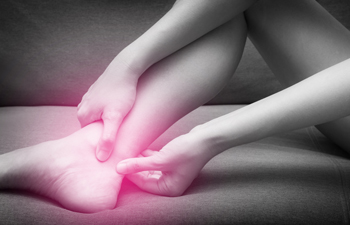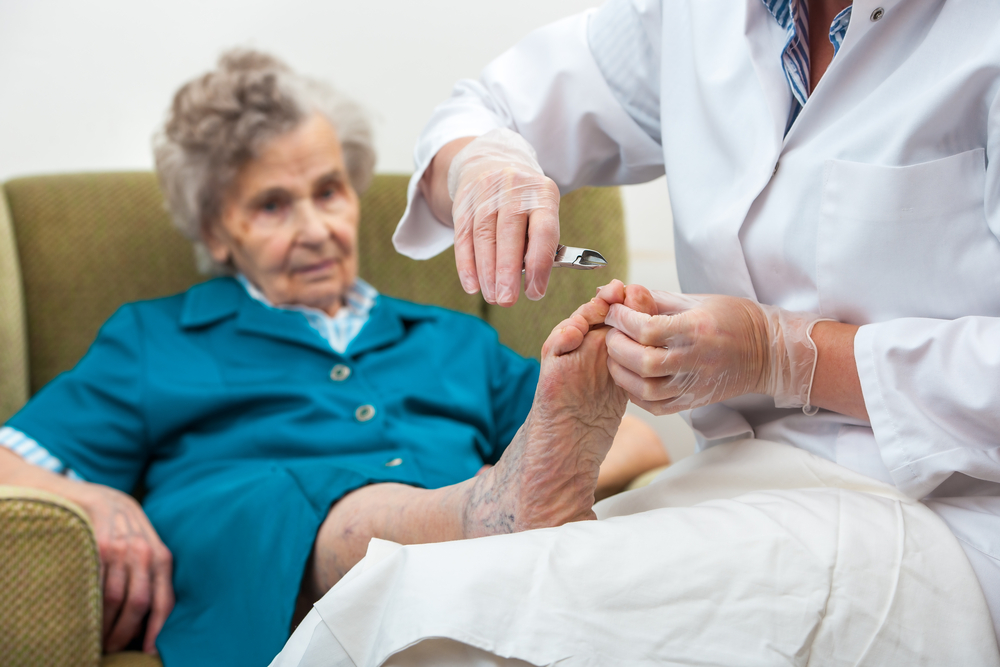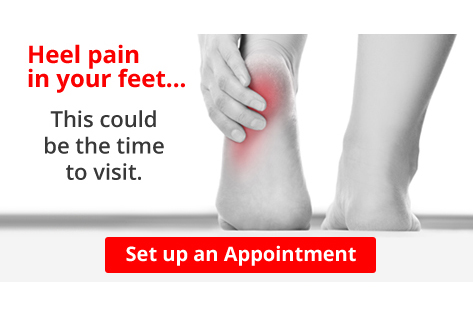 The Achilles tendon is known to be the largest tendon in the body. It connects the heel to the calf muscles and is responsible for allowing the foot to point and flex. There are several symptoms patients notice if this tendon should become torn. These often include extreme pain in the back of the ankle, swelling, bruising, or a popping sound as the injury happens. It is common for the Achilles tendon to become weak as the aging process occurs, or if medical conditions such as diabetes or arthritis exist . Additionally, this condition may occur if you fall unexpectedly or suddenly step off a curb. If you have ruptured your Achilles tendon, it is suggested that you meet with a podiatrist who can discuss the best treatment options for you.
The Achilles tendon is known to be the largest tendon in the body. It connects the heel to the calf muscles and is responsible for allowing the foot to point and flex. There are several symptoms patients notice if this tendon should become torn. These often include extreme pain in the back of the ankle, swelling, bruising, or a popping sound as the injury happens. It is common for the Achilles tendon to become weak as the aging process occurs, or if medical conditions such as diabetes or arthritis exist . Additionally, this condition may occur if you fall unexpectedly or suddenly step off a curb. If you have ruptured your Achilles tendon, it is suggested that you meet with a podiatrist who can discuss the best treatment options for you.
Achilles tendon injuries need immediate attention to avoid future complications. If you have any concerns, contact Dr. Frederick Quirante of Texas. Our doctor can provide the care you need to keep you pain-free and on your feet.
What Is the Achilles Tendon?
The Achilles tendon is a tendon that connects the lower leg muscles and calf to the heel of the foot. It is the strongest tendon in the human body and is essential for making movement possible. Because this tendon is such an integral part of the body, any injuries to it can create immense difficulties and should immediately be presented to a doctor.
What Are the symptoms of an Achilles Tendon Injury?
There are various types of injuries that can affect the Achilles tendon. The two most common injuries are Achilles tendinitis and ruptures of the tendon.
Achilles Tendinitis Symptoms
- Inflammation
- Dull to severe pain
- Increased blood flow to the tendon
- Thickening of the tendon
Rupture Symptoms
- Extreme pain and swelling in the foot
- Total immobility
Treatment and Prevention
Achilles tendon injuries are diagnosed by a thorough physical evaluation, which can include an MRI. Treatment involves rest, physical therapy, and in some cases, surgery. However, various preventative measures can be taken to avoid these injuries, such as:
- Thorough stretching of the tendon before and after exercise
- Strengthening exercises like calf raises, squats, leg curls, leg extensions, leg raises, lunges, and leg presses
If you have any questions please feel free to contact our office located in Nederland, TX. We offer the newest diagnostic tools and technology to treat your foot and ankle needs.
Read more about What are Achilles Tendon Injuries Research has indicated that one of the reasons elderly people develop uncomfortable foot conditions can come from a loss of cushioning in the feet. Additionally, as the aging process occurs, poor circulation is a common ailment among seniors. This can make it difficult for foot sores to heal properly. This condition may be remedied by sitting frequently throughout the day, and it is helpful to periodically stretch the feet. There are some foot conditions that can be avoided when the proper shoes are worn, and these often include corns, calluses, or bunions. Many elderly people develop athlete's foot, which is a contagious foot ailment. Wearing appropriate shoes while in public swimming pools, locker rooms, and surrounding areas can help to prevent this uncomfortable foot condition. It is suggested that you consult with a podiatrist if you would like additional information about how to care for elderly feet.
Research has indicated that one of the reasons elderly people develop uncomfortable foot conditions can come from a loss of cushioning in the feet. Additionally, as the aging process occurs, poor circulation is a common ailment among seniors. This can make it difficult for foot sores to heal properly. This condition may be remedied by sitting frequently throughout the day, and it is helpful to periodically stretch the feet. There are some foot conditions that can be avoided when the proper shoes are worn, and these often include corns, calluses, or bunions. Many elderly people develop athlete's foot, which is a contagious foot ailment. Wearing appropriate shoes while in public swimming pools, locker rooms, and surrounding areas can help to prevent this uncomfortable foot condition. It is suggested that you consult with a podiatrist if you would like additional information about how to care for elderly feet.
Proper foot care is something many older adults forget to consider. If you have any concerns about your feet and ankles, contact Dr. Frederick Quirante from Texas. Our doctor can provide the care you need to keep you pain-free and on your feet.
The Elderly and Their Feet
As we age we start to notice many changes in our body, but the elder population may not notice them right away. Medical conditions may prevent the elderly to take notice of their foot health right away. Poor vision is a lead contributor to not taking action for the elderly.
Common Conditions
- Neuropathy – can reduce feeling in the feet and can hide many life-threatening medical conditions.
- Reduced flexibility – prevents the ability of proper toenail trimming, and foot cleaning. If left untreated, it may lead to further medical issues.
- Foot sores – amongst the older population can be serious before they are discovered. Some of the problematic conditions they may face are:
- Gouging toenails affecting nearby toe
- Shoes that don’t fit properly
- Pressure sores
- Loss of circulation in legs & feet
- Edema & swelling of feet and ankles
Susceptible Infections
Diabetes and poor circulation can cause general loss of sensitivity over the years, turning a simple cut into a serious issue.
If you have any questions please feel free to contact our office located in Nederland, TX. We offer the newest diagnostic and treatment technologies for all your foot and ankle needs.
Read more about Elderly and their Feet Corns and calluses are both forms of hardened skin that appear on the foot, but they are not the same condition. Neither condition is dangerous, but both can cause discomfort or irritation. Corns and calluses usually develop as a reaction to pressure or friction. Standing for long periods of time, sweating, and wearing ill-fitting shoes make one more prone to developing corns or calluses. Calluses and corns vary in where they are likely to appear and their shape. Calluses usually appear on the soles of the feet, while corns often occur on the non-weight bearing parts of the skin. Calluses can vary in shape, while corns are normally small, round, and defined. Corns are also more likely to be more painful than calluses. If you are experiencing pain with either corns or calluses, consult with a podiatrist about the best treatment option for you.
Corns and calluses are both forms of hardened skin that appear on the foot, but they are not the same condition. Neither condition is dangerous, but both can cause discomfort or irritation. Corns and calluses usually develop as a reaction to pressure or friction. Standing for long periods of time, sweating, and wearing ill-fitting shoes make one more prone to developing corns or calluses. Calluses and corns vary in where they are likely to appear and their shape. Calluses usually appear on the soles of the feet, while corns often occur on the non-weight bearing parts of the skin. Calluses can vary in shape, while corns are normally small, round, and defined. Corns are also more likely to be more painful than calluses. If you are experiencing pain with either corns or calluses, consult with a podiatrist about the best treatment option for you.
Corns can make walking very painful and should be treated immediately. If you have questions regarding your feet and ankles, contact Dr. Frederick Quirante of Texas. Our doctor will treat your foot and ankle needs.
Corns: What Are They? And How Do You Get Rid of Them?
Corns are thickened areas on the skin that can become painful. They are caused by excessive pressure and friction on the skin. Corns press into the deeper layers of the skin and are usually round in shape.
Ways to Prevent Corns
There are many ways to get rid of painful corns such as:
- Wearing properly fitting shoes that have been measured by a professional
- Wearing shoes that are not sharply pointed or have high heels
- Wearing only shoes that offer support
Treating Corns
Although most corns slowly disappear when the friction or pressure stops, this isn’t always the case. Consult with your podiatrist to determine the best treatment option for your case of corns.
If you have any questions please feel free to contact our office located in Nederland, TX. We offer the newest diagnostic and treatment technologies for all your foot and ankle needs.
Read more about Everything You Need to Know About Corns






